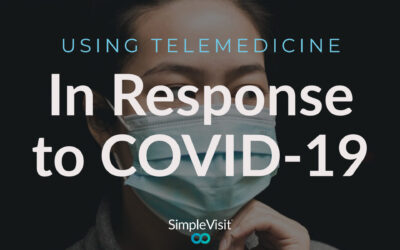5 Reasons Why Your Telemedicine Program Isn’t Working
Best Practices | August 14, 2019
In the healthcare industry, the benefits of telemedicine are widespread and commonly understood. Integrating video appointments into your practice is no longer considered revolutionary. If you are one of the many providers who have already implemented a telemedicine solution, you know all too well that developing the program is half the battle.
You have spent the money and bought the tech. You upgraded your network capabilities and updated your website. You told your staff and patients. And then you waited. You waited for the appointments to stack up, for the return to pour in. And you’re still waiting.
If this sounds all too familiar, you are not alone. Surveys say that 69 percent of providers and 83 percent of consumers are interested in using telemedicine. It was estimated that by 2020 the telemedicine technology market would be valued at $36.2 billion, and the yearly implementation costs for a telemedicine program run an average of $59,000. But the most recent studies have also shown that only 9.6% of patients have actually used telemedicine. Now that the days of healthcare transparency are upon us and telemedicine is becoming more mainstream, consumers are becoming more selective and demanding in what they want to use. As more options appear and technology charges forward at the speed of light, the choices of how to do it aren’t as clear-cut as they were when telehealth was new. In order to stay competitive in a market where 90% of healthcare organizations are utilizing some form of virtual care services, it’s important, not only to do it, but to do it well.
So what aren’t you doing that you should be? Read on to find the 5 common reasons why a telemedicine program fails.
Your telemedicine workflow isn’t streamlined
If you find that your program isn’t working, the first thing to do is see if the problem is internal, not external – maybe it’s not that your patients don’t want to use telemedicine, but that the way you have integrated it into the office they know and love isn’t effective. To determine if this is the case, you need to evaluate your workflows: past and present. How did your office run at all points of care before you implemented this new program and how does it run now? Break it down step-by-step, from the moment a patient makes an appointment through to when they are checking out and scheduling their next one. Then, ask yourself: how different are these two processes? How many new steps or processes have you added? It is recommended that you only add or change 3-5 steps in an already-effective workflow to keep it running smoothly when making enterprise changes to a business or office. Even if you find it necessary to change more than that, or if your previous workflow wasn’t working effectively for your office anyway (perhaps, hence the addition of telemedicine), look at your current workflow and see if you can cut down on the number of steps you, your staff, and your patients have to complete to get through the whole process – or you might find one too many people giving up half-way through.
On that note, another thing to keep in mind when you are examining your methods and procedures: Your receptionist or scheduler’s workflow is as important as your own as the provider or doctor-owner, if not more so. They are the people that make sure your patients understand what they have to do, get it done correctly, and that you have what you need at the right time. If their workflow is clumsy and overencumbered, the whole thing will be slowed down and harder for everyone to navigate.
[For an example of an efficient Telemedicine workflow, check out our Sample Urgent Care Workflow]
You face obstacles around cost.
Another common set of misconceptions that can get in the way of both providers and patients adopting and enjoying all the benefits of a telemedicine program has to do with money.
The first is that you need all sorts of fancy equipment in order to do telemedicine well. With each advance in the technology that is at the core of telehealth, video calling, that becomes less and less the case. Now you really don’t need much more than your phone or tablet with a built in or external camera, a quiet room, and an internet service capable of handling live streaming video. If you have those things, then there are services, such as SimpleVisit, that can help you do telemedicine regardless of how your patient needs or wants to receive it.
The second is that it will cost you more to upkeep, so you have to charge your out of pocket clients more to cover it, which effectively renders the option unattractive. A recent J.D. Power study showed that 64.4% of consumers would be more likely to choose telemedicine over an office visit if it costs less than their copay, and research has proven that a video visit costs an average of $67 less than a normal office visit and saves approximately $50 on transportation costs. Combined with the information in the section above, communicating this effectively to your patients can make all the difference in their reception of your telemedicine program. You can tell them, “Yes, you can afford this, and you can afford it more than in-office visits,” while being secure in the knowledge that your business can afford it, too.
[See our recent article on “How to Price Out-Of-Pocket Video Visits” for more guidance on best practices.]
Your clients aren’t aware of your service offerings
Lack of awareness is an astonishingly common reason for lack of patient adoption of telemedicine. The same study from J.D. Power referenced above stated that only 17.2% of consumers are aware that their health system or insurance provider offers telehealth. So once again, you are far from being alone in this boat. The reasons for this lack of awareness most often boil down to these three factors:
Sufficient Advertising Materials
Often, the reason is simple: people don’t know because they haven’t been told. Or at least, not told enough. There is a common principle in marketing called the Rule of 7: it states that a consumer needs to be exposed to your offer a minimum of seven times, amid the noise of the rest of the world trying to get their attention, to remember it. It has also been proved that the more ways you receive a piece of information (eg., auditory, visual, and kinetic) the easier it will stick and stay in your memory. So just having a little pamphlet advertising your new telemedicine service sitting on the coffee table among the magazines in your lobby isn’t enough. Some ideas for ways to advertise are as follows:
- Floor sign when you first walk through the door
- Stand-up sign or rack card at the reception desk where they make appointments
- Pre-recorded message that can be played during your hold music or recording
- Banner or graphic on your website
- Message on the scheduling page of your patient portal
- Slide on a scrolling loop on a TV screen in your lobby or waiting room
- Reminder that they can schedule virtually on the appointment reminder cards they are given to take with them
- Postcards in a bulk mailing
Clarity of Message
What you are saying is just as important as how you are sharing your message. Try out a lot of ways to say what you offer – sometimes the first thing that comes to mind is the way you, a highly educated medical and business professional would think about what telemedicine care delivery is, not necessarily how your patients will best understand it. Be sure to include what you do (eg., video visits), when or what hours, how much it costs the patient, and a short and compelling list of why they should care.
Correct Targeting of Information
Knowing who you are speaking to is also equally as important as what you are saying and how you are saying it. Take a deep dive into your patient demographics and those of your community. The information you find there can be essential to knowing how to present your service offering in a way that makes those particular consumers want to use it. For all that we in the healthcare industry don’t like to look at what we do as a business, since our primary goal and driving force is to help and heal people, in this process you have to remember that you are selling yourself, or your service at least, in a world where every other practice is doing the same. What makes you unique and how are you doing telehealth different than everyone else? Why should those particular consumers choose your particular brand of telehealth? What is going to make those types of people buy into your program – what do they care about, what are their lives like, what choices do they have to make, what are their habits, etc?
Your solution isn’t professional
Once you’re sure you have found and addressed any problems in your advertising, it’s time to look at the telemedicine solution you are using and how it is experienced on the other end by the patient.
How you come across to the patient can have a lot of bearing on the success or failure of your program. What is in the frame, what you are wearing, how easy it is to see you clearly, and your non-verbal cues all factor into whether a patient feels like they can trust that the care they are receiving virtually meets the same quality standards as the care they receive in-office from you.
[Stay tuned or subscribe to our newsletter below for our upcoming series installment “Setting the Stage”, a unique take on how to craft the right atmosphere for an excellently executed video visit every time.]
There are two other considerations to keep in mind about how your video visits are experienced. One is whether it is branded – is there a clear visual representation of your brand, your office, the name and logo that your patients have come to trust and recognize as uniquely yours? The other is how well any in-between people are trained on your new program. That could include in-office receptionists or schedulers, schedulers at a call center, a trained healthcare professional assisting on the patient’s end to collect healthcare data (called a “telepresenter”), or even a telemedicine receptionist who helps troubleshoot technical problems and handles the warm hand-off between you and your patient in real-time at the start of your virtual appointment (only at Simple Visit – click here to learn more about how our telemedicine receptionist can help you reach your telehealth program goals today!)
Your telemedicine solution is not user-friendly
Last but not least to consider is how easy is your telemedicine solution to use? In the fast food drive through, DoorDash and Uber Eats, AmazonPrime Same Day Shipping, drive-up and mobile banking culture that we are living in today, any extra step for your patients is one too many and can make or break your program. Here are some ways you can make ease-of-use a hallmark of your program and stand out from the rest:
Use What They Have & Know
Using what they are already familiar with is going to increase the chances of success for your telemedicine program. Allowing them to use the devices they already have with the apps they already use by choosing a solution that works with them is one way to guarantee ease-of-use for your consumer.
[Click here to download our white paper on “Using Facetime for Telemedicine”]
Minimum Extra Tech or Downloading
Along the same lines, don’t make them download a new app or learn how to navigate a page or fill out another form to access your care – make it easy for them. With SimpleVisit, we make access to care as simple as picking up a phone call – one example of the height of making the patient experience comfortable and effortless.
Unavailable or Unhelpful Tech Support
No matter how easy you make it, with the least amount of foreign tech or fancy systems possible, the one thing you can count on with technology is that eventually, it won’t work. Then you are faced with having to call in the dreaded tech support. Often that means waiting on hold forever, or sending rapid-fire messages to a faceless bot trying to save your appointment before your next one, or clicking on lots of links or reload buttons and logging out and logging in over and over. And in the end, you might not get it fixed or figured out in time, which can cost you both the current appointment that now has to be rescheduled, but can also cost you the faith of your patient in your telemedicine program as a whole, which can ultimately be more damaging to your bottom line. Instead, choose a telemedicine solution that has live and readily-available tech support.
You can absolutely make this work!
So you’ve read this far, and you’ve identified the flaw (or flaws) in your program that could be keeping it from becoming the success you dreamed of when you started it. What now? Along with the resources mentioned throughout the above, here is a recap of things you can do today to move forward with readjusting your program to better serve you, your business, and your patients.
Reevaluate your solution:
- How much does it cost?
- Is it user-friendly?
- Are all the elements professionally executed?
- Do you have adequate built-in tech and office support?
- Does it have interoperability with other established HIT solutions (EHR, scheduling, etc.) & current workflows?
[Consider training for your staff to improve your workflow execution]
Reevaluate your pricing:
- Is it competitive?
- Do you understand reimbursement regulations and policies enough to take full advantage of what payers cover?
[For an overview of reimbursement considerations, see our Road to Reimbursement series or look for the white paper coming soon!]
Reevaluate your advertising:
- Consider adding multiple delivery mechanisms (not just a flyer in your waiting room)
- Target your advertising campaigns to be tailored to the population you are trying to engage
- In some situations it may be necessary to revamp your marketing plan entirely. In such cases, it might be wise to consider hiring out.
[Call SimpleVist at 877.83.VISIT for recommendations on companies who can help you get your marketing strategy back on track]
We here at SimpleVisit believe in telemedicine and are committed to helping providers do telemedicine well, with ease. To that end, we have developed a Resource Library that has answers to these questions and so many more. We also have telemedicine specialists who can work with you one-on-one to help you figure out the best way to meet your goals for your telemedicine program and start seeing returns right away! Call 877.83.VISIT or email info@simplevisit.com to speak to a representative today.
For even more helpful news and resources, subscribe to our newsletter with the form at the bottom of this post.
You can do this! Our team is happy to help you successfully engage your patients over video visit telemedicine.

Allie Clark
Allie is an Industry Analyst and Content Manager for SimpleVisit. Her educational background is diverse with Administrative Medical Assisting and Psychology as a focus with a dash of Business Communication and Theater. Unique life experiences have led to a passion for improving access to healthcare and a particular talent for research, which she is quickly turning into a career. Allie is able to use her combined experience to write and develop resources for SimpleVisit, and is fulfilled by the opportunity to contribute to innovation and progress in the healthcare industry as a whole.
Industry Leaders Push for Permanency for Telehealth Coverage Expansions
Allie Clark | 8 min read | June 8, 2020During the COVID-19 pandemic, telehealth has been necessary for not only the health of all American citizens, but also that of healthcare companies of all sizes. Virtually delivered services have kept many medical offices open...
Allie Clark | 10 min read | March 6, 2020[Updated on November 20, 2020] Our world is in the throes of what is undeniably one of the most severe infectious disease outbreaks in modern history. Coming up with innovative approaches to stem the spread of the infection of...
20/20 Vision: Presidential Panorama
Allie Clark | 6 min read | February 10, 2020[Updated March 10, 2020]As we continue on into 2020, more opportunities for growth and advancement of virtual care delivery abound. This year also brings the single biggest event that happens in our country: a presidential...



